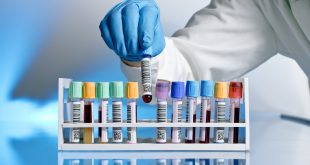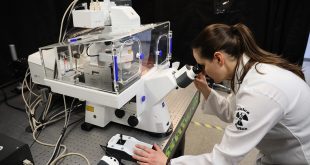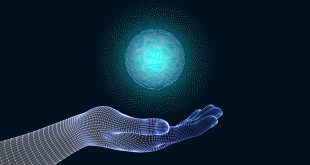As technologies continue to evolve and their capabilities expand, it seems only a matter of time until the real impacts of AI begin to take hold
By Sean Tarry
As technological innovation continues to advance at bewildering speeds, the related capabilities of the tools we use and the computational power with which we work enhances significantly, impacting just about every aspect of our lives. When it comes to its use and utility within the life sciences and healthcare industries, it’s just as prevalent, helping to shape the future of discovery and care every day. Driven by the wonders of AI) and machine learning, the promise within many fields of medical science is being tapped in earnest for the very first time, leading to brand new areas of research and an entire new world of potential and possibility for scientists and their teams everywhere.
With this continued innovation and advancement in mind, BioLab Business sat down with Amol Deshpande, Senior Director Health Sciences, Ecosystem and Capital, Venture Services, MaRS Discovery District, to explore the current state of the use of AI and machine learning within the life sciences and healthcare sectors, the ways in which these technologies are being deployed today, some of the challenges that are limiting its impact, and the extent to which they’ll be leveraged in the future to aid further scientific research and discovery.
BioLab: When it comes to health sciences, how important is the continued evolution of technologies, particularly those driven by machine learning and artificial intelligence?
Amol Deshpande: Technology is absolutely critical to all of life sciences and health sciences, all the way from drug development and diagnostics to therapeutics and predictive technologies. It’s critical to the lifeblood of healthcare. If you’re looking at AI or machine learning, it will eventually touch all points of life sciences, from drug discovery through to clinical care. It’s only a matter of time before machine learning pervades each of those areas. Within drug discovery, we’re certainly seeing lots of AI use, from big pharma to start-ups and everyone in between, in efforts to tap into the power that AI can potentially provide. I believe that we still haven’t quite reached the tipping point of adoption and use. However, investments are being made by many of the larger companies, including Sanofi, Johnson & Johnson, and Merck & Co. They’re all looking at how they can leverage AI and machine learning to really ramp up that aspect of their own development portfolios.
BL: In your estimation, in what way(s) is AI most dramatically impacting the future of health sciences?
AD: If we’re looking at where AI is deployed today in terms of actual use cases, it’s still very early stages regarding the drug discovery pathway, and that’s often for very good reasons. Regulatory issues don’t pose much of a hurdle. Our ability to train systems has also enhanced over recent years. We have lots of patient data. But the problem is that we don’t have a lot of curated patient data. Currently, systems can be trained using data in highly contrived settings. However, when we put it into practice to use out in the real world, the data is incomplete for a number of different reasons. Because of this, the deployment of AI and its impact on patient care may take a little more time. But, as mentioned, on the front end AI is being used widely to enhance areas like drug discovery and diagnostics with respect to assisting instrumentation.
BL: How important is the digitization of healthcare and the role that data plays when it comes to closing gaps within the healthcare system?
AD: The generation of curated actionable data is absolutely paramount to the future of life sciences innovation. Without it, machine learning cannot happen., rendering the training of AI models impossible. However, as I already mentioned, the quality of the data reflects to a large extent our ability to use it to train models. So, we need to somehow figure out how to go from research environment data to data that’s going to help in the real world. This is going to require tweaking the ways in which we’ve digitized healthcare. With respect to the data, at least, some believe that some sort of standardization might work by which everyone feeds their data into a cloud that’s anonymized from which the AI can access it, as opposed to reaching way back into the hospital system itself to find it. There are ways that the proper digitization of the healthcare system in this way can be achieved. And, although nothing has yet come to fruition, I firmly believe that the power and potential inherent in AI and machine learning within the healthcare environment will become so great that we’ll be forced to do what we need to do in order to facilitate its full potential.
BL: In your estimation, what is the greatest untapped potential offered by AI and machine learning when it comes to health sciences?
AD: The biggest potential of these technologies, without a doubt, is the impact that machine learning can possibly have on clinical care, particularly with regards to diagnostic capacity. There’s a recent study that was published within JAMA [Journal of the American Medical Association] in which electronic health record (EHR) data was used to predict an individual’s chance of developing pancreatic cancer. But that’s not the ‘aha’. The ‘aha’ is the fact that they could put a timeframe on it. So, not only were physicians able to let the patient know that they had pancreatic cancer, but they knew exactly when the disease was going to be contracted. Again, this was done using only standard EHR data. There weren’t any genomics used, or biomarkers. This discovery is such a breakthrough because until now, when pancreatic cancer or the development of it is identified in the patient, it’s often too late; the patient is already experiencing symptoms, and the tumour has already become enlarged, reducing the patients’ life expectancy to about another 10 to 15 months, at best. So, with the potential of machine learning, we suddenly have the opportunity to predict the development of diseases in individuals who are not yet even symptomatic, possibly saving many lives as a result.
BL: Looking ahead over the course of the next one to three years and beyond, what might present the biggest hurdle to the continued advancement and use of AI and machine learning in healthcare?
AD: The biggest challenge that I anticipate is in figuring out a way to allow this technology to permeate throughout the entire healthcare ecosystem. How do we, for instance, better identify patients for clinical trials? If a company spends $100 million on a clinical trial, their hope is that the data they get out of it is accurate and favourable. However, if the wrong patients are selected, the data can absolutely be skewed, altering the efficacy of the trials. Machine learning has the ability to fine-tune clinical trials. And, once we’re able to correct these inconsistencies, the next big thing for AI and machine learning will be predictions. If we feed these technologies enough optimal data, the predictions are going to get closer and closer to more and more accurate results. One clinician in a room knows what they know. However, if that one clinician suddenly has the power and insights of all the other clinicians who are seeing similar patients, multiplying their knowledge and experience by 10,000 or so, they’re able to serve their own patients better. This just isn’t possible without machine learning.
 BioLab Business Magazine Together, we reach farther into the Canadian Science community
BioLab Business Magazine Together, we reach farther into the Canadian Science community





